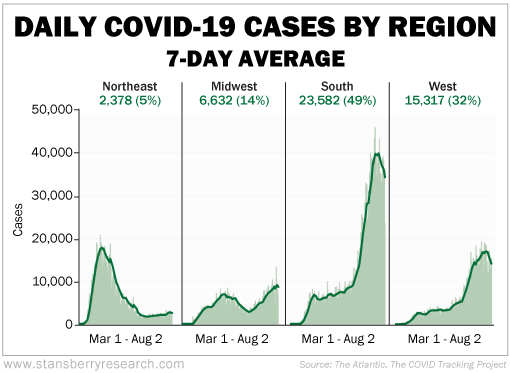Everyone is sick and tired of the COVID-19 pandemic.
That includes me.
I'm sick of the fearmongering, the lack of consistent data reporting, and the ridiculous notion of keeping folks shut in their own houses with no end in sight.
Last month, I challenged my Retirement Millionaire readers to make their own decisions regarding going out and about in a COVID-19 world. It's time we stop living in fear.
That's why my team and I put together five questions to help guide you when deciding on which activities are safe and how much risk you're really taking. We want you to use these questions to make decisions in your best interest. Not the interest of other people or the government – but yours.
Today, let's look at one of the questions regarding where you live.
To really understand your local situation, you need to ask: What's the risk in my state?
This is a tricky question. It's one that my analyst Matt Weinschenk and I cover in our biweekly COVID-19 briefings (check them out in Dr. Eifrig's COVID-19 Information Center here). And states have had varying levels of success.
As we write, the Northeast has fallen from its peak. The South and West are seeing numbers fall, but the Midwest is seeing consistent numbers. Take a look at the data from The Atlantic's COVID Tracking Project:

Even within regions, some states are having a harder time containing COVID-19 than others. Florida, for example, had three days in a row last week of record-breaking COVID-19 deaths. But it's important to keep in mind that most of the folks with new infections there are much younger. So if you're in the Sunshine State, you're less likely to get infected from a friend your age than you are from your kids or grandkids.
Just remember, this isn't exclusively an explosion of cases because of premature reopenings. It also corresponds with much higher testing capacity. A few months ago, we didn't have enough tests. We only tested people with symptoms – and in most cases, only symptomatic folks who also had higher risks for complications. We know plenty of people who likely had the virus but didn't get a test because they weren't "high risk." It didn't matter if you had small children, cared for older adults, or anything else – if you weren't older than 65 or hadn't spent time in China, you could forget about getting a test.
But now, we're testing everyone. And that's ramping up the number of cases reported, especially in young, healthy folks with few – if any – symptoms.
A better way to look at the numbers is to look at how many of the tests come back positive. Florida, for instance, had a problem when its Department of Health only reported positive tests, making everyone scared about the huge surge in numbers. Some small labs reported a nearly 100% positivity rate. But Florida failed to report negative test results. That artificially inflated the positivity rate.
In mid-July, the number of test results per day in Florida reached almost 150,000. The correct positive rate is currently sitting at 19%.
That number – 19% – would scare most people. But we don't scare so easily here at Health & Wealth Bulletin. That's because we know that the rise comes from:
- More tests for everyone
- Bars and restaurants opening
- More people getting out and about
- More young folks with few symptoms gathering and spreading the virus
So it's up to you to stay safe. Tell your young relatives not to get near you. You have the freedom to tell them not to come visit you if they've been reckless about going out and about in hot spots like Florida.
One more thing to understand about state hotspots... You need to know how many of those cases are in nursing homes.
That's because in many states, nursing homes are hotspots of COVID-19 cases. If you're in one, you're in TROUBLE.
The Foundation for Research on Equal Opportunity ("FREOPP") has tracked COVID-19 deaths by state, as well as how many of those deaths occurred in assisted-living or nursing homes.
Here are the five highest:
- New Hampshire: 82.1%
- North Dakota: 80.8%
- Rhode Island: 79.8%
- Minnesota: 77.9%
- Ohio: 69.3%
You can find your state's information here.
Finally, look at your state's case fatality rate. This is often a better reflection than the nationwide statistics for your age range. You should be able to find that on your state's health department website. It should also have real-time tracking for outbreaks and the most up-to-date advisories. There's a directory to help you find that information here.
This is just one of the five areas we wrote about to help you make the best decision for your health this summer. Current Retirement Millionaire subscribers can read the rest of the issue here. If you aren't a subscriber, sign up today to get more health and wellness tips, great stock recommendations, and secrets to living a retirement lifestyle right here.
What We're Reading...
- Keep up with my biweekly COVID-19 conversations right here.
- Something different: Waking up ancient lifeforms might not be the best 2020 plan.
Here's to our health, wealth, and a great retirement,
Dr. David Eifrig and the Health & Wealth Bulletin Research Team
August 4, 2020
